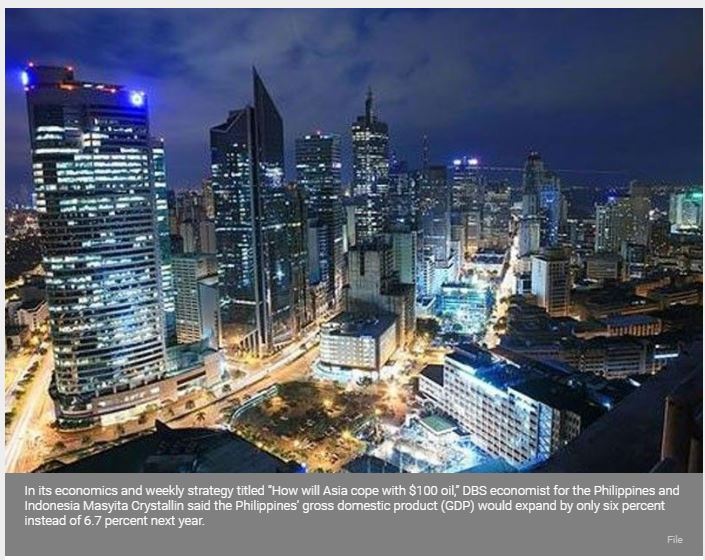‘Higher oil prices to result in lower Philippine growth’
MANILA, Philippines — DBS Bank Ltd. of Singapore said the Philippines’ economic growth would ease further while inflation would continue to soar in 2019, if the price of oil hits $100 per barrel as the US ratchets up sanctions on Iran.
In its economics and weekly strategy titled “How will Asia cope with $100 oil,” DBS economist for the Philippines and Indonesia Masyita Crystallin said the Philippines’ gross domestic product (GDP) would expand by only six percent instead of 6.7 percent next year.
She said the peso would also depreciate to a new record low of 60 to $1 instead of 56.5 to $1 next year under the $100 per barrel price of oil scenario.
She added this would translate to a wider current account deficit of three percent of GDP instead of 1.4 percent per GDP as importers would have to shell out more greenbacks to pay for oil shipments.
According to Crystallin, oil imports have a big impact on trade as it account for more than 10 percent of total imports.
In the first seven months of the year, there was an additional $14 billion of imports that were mostly due to oil price increases.
Furthermore, Crystallin warned remittances from overseas Filipinos continue to weaken.
“Widening trade deficit and possibly weaker consumption due to lower purchasing power, will adversely impact growth. Under this scenario, GDP growth in 2019 will only reach six percent compared to 6.7 percent in our baseline,” she said.
The economist said inflation could average 5.9 instead of 5.5 percent next year as an oil price scenario of $100 could boost inflation by 0.4 percentage point.
This, she said, would prompt the Bangko Sentral ng Pilipinas (BSP) to raise interest rates by 75 basis points instead of only 50 basis points next year.
“Given that the Philippines economy is currently overheating, BSP will likely raise rates further by at least another 75 basis points to contain inflation in our baseline scenario. If oil goes to $100, there could be another 50-basis point upside to the policy cycle,” Crystallin said.
Under its baseline scenario, DBS expects the country’s GDP to expand 6.7 percent this year and next year. On the other hand, it sees inflation averaging six percent this year and 5.5 percent next year.
The country’s GDP growth eased to its slowest pace of six percent in the second quarter from 6.6 percent in the first quarter, bringing the first half average to 6.3 percent.
On the other hand, inflation leapt to 6.7 percent in September from 6.4 percent in August due to higher oil and food prices, weak peso, and the impact of the implementation of Republic Act 10963 or the Tax Reform for Acceleration and Inclusion (TRAIN) Law.
This brought the average to five percent in the first nine months of the year, exceeding the BSP’s two to four percent target.
The BSP’s Monetary Board has so far raised interest rates by 150 basis points since May to curb rising inflation and keep inflationary expectations well anchored.
Based on its latest assessment, the central bank now expects inflation to average 5.2 instead of 4.9 percent this year and 4.3 instead of 3.7 percent next year.
Source: https://www.philstar.com/business/2018/10/08/1858109/higher-oil-prices-result-lower-philippine-growth#PPEM4ZPoa1txr8fJ.99


 Thailand
Thailand




